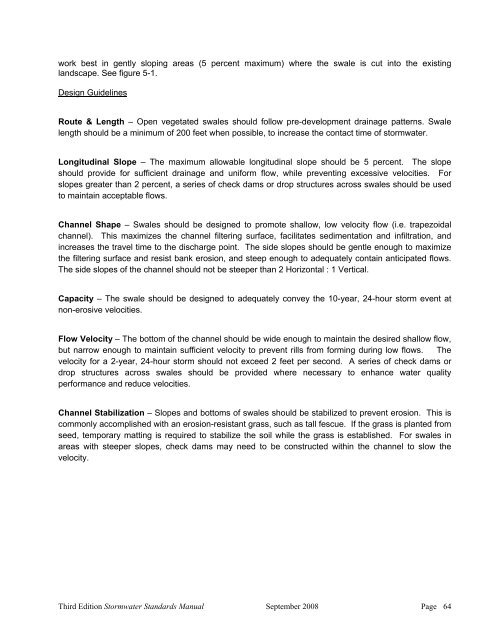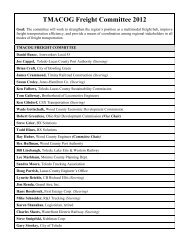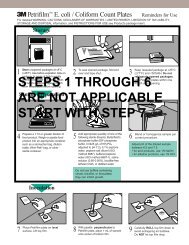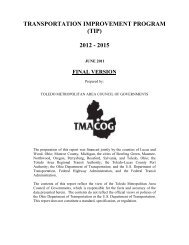Stormwater Management Standards Manual - Toledo Metropolitan ...
Stormwater Management Standards Manual - Toledo Metropolitan ...
Stormwater Management Standards Manual - Toledo Metropolitan ...
You also want an ePaper? Increase the reach of your titles
YUMPU automatically turns print PDFs into web optimized ePapers that Google loves.
work best in gently sloping areas (5 percent maximum) where the swale is cut into the existing<br />
landscape. See figure 5-1.<br />
Design Guidelines<br />
Route & Length – Open vegetated swales should follow pre-development drainage patterns. Swale<br />
length should be a minimum of 200 feet when possible, to increase the contact time of stormwater.<br />
Longitudinal Slope – The maximum allowable longitudinal slope should be 5 percent. The slope<br />
should provide for sufficient drainage and uniform flow, while preventing excessive velocities. For<br />
slopes greater than 2 percent, a series of check dams or drop structures across swales should be used<br />
to maintain acceptable flows.<br />
Channel Shape – Swales should be designed to promote shallow, low velocity flow (i.e. trapezoidal<br />
channel). This maximizes the channel filtering surface, facilitates sedimentation and infiltration, and<br />
increases the travel time to the discharge point. The side slopes should be gentle enough to maximize<br />
the filtering surface and resist bank erosion, and steep enough to adequately contain anticipated flows.<br />
The side slopes of the channel should not be steeper than 2 Horizontal : 1 Vertical.<br />
Capacity – The swale should be designed to adequately convey the 10-year, 24-hour storm event at<br />
non-erosive velocities.<br />
Flow Velocity – The bottom of the channel should be wide enough to maintain the desired shallow flow,<br />
but narrow enough to maintain sufficient velocity to prevent rills from forming during low flows. The<br />
velocity for a 2-year, 24-hour storm should not exceed 2 feet per second. A series of check dams or<br />
drop structures across swales should be provided where necessary to enhance water quality<br />
performance and reduce velocities.<br />
Channel Stabilization – Slopes and bottoms of swales should be stabilized to prevent erosion. This is<br />
commonly accomplished with an erosion-resistant grass, such as tall fescue. If the grass is planted from<br />
seed, temporary matting is required to stabilize the soil while the grass is established. For swales in<br />
areas with steeper slopes, check dams may need to be constructed within the channel to slow the<br />
velocity.<br />
Third Edition <strong>Stormwater</strong> <strong>Standards</strong> <strong>Manual</strong> September 2008 Page 64
















